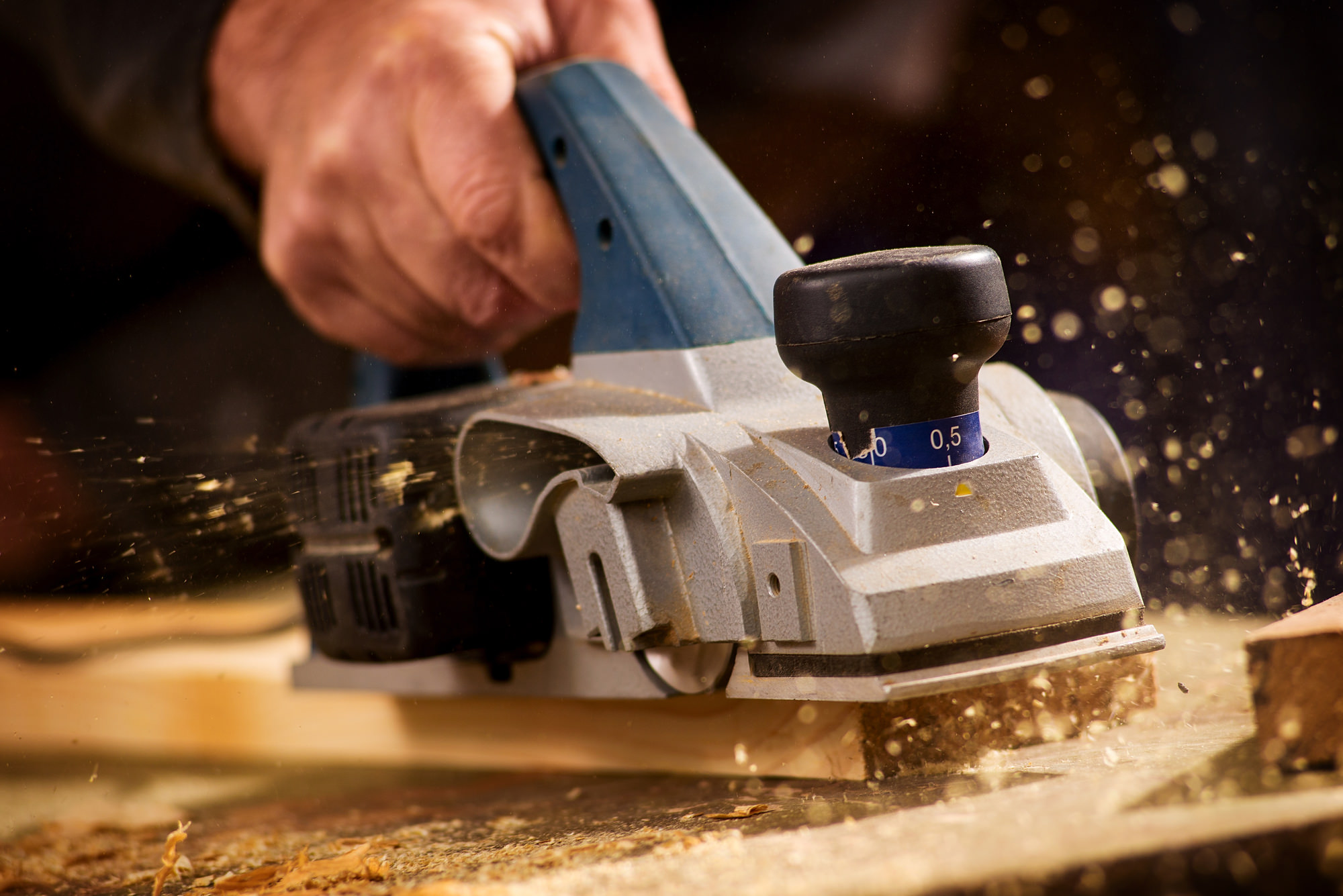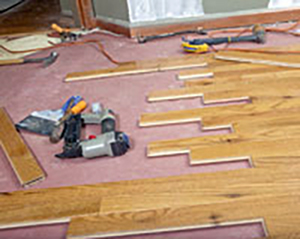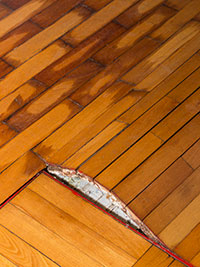Too Wet or Too Dry Woodworking: A Sticky Situation

Everyone who has spent time working with wood knows that the moisture levels can vary from piece to piece and from source to source. They also may have seen their wood change after it was delivered to their shop or job site – twisting, cracking, warping and otherwise not retaining its shape or dimensions. When working with wood to create your own projects, this can be problematic. When working with wood flooring, this can be disastrous.
Why does it happen? Wood is a hygroscopic material that absorbs and releases moisture from its environment, and until it is fully sealed, this is an ongoing, never-stopping process. Sawmills and wood product manufacturers invest heavily in monitoring wood’s moisture content (MC) and removing excess moisture from the wood. However, even with their care, once the wood is transported to another location, the moisture cycle of wood will continue to work to try to balance with its environment.
How does that present a problem for the people and professionals who work with wood? Any time MC is too high (or too low) for its use and environment, the end result is put at risk, along with a few other things along the way.
The Stakes of Unknown Moisture Content
First, let’s look at some of the challenges if the wood is too “wet” or has a high MC.
Shrinkage
Wood that has a high MC level will begin to shrink in all dimensions as it begins to lose that excess moisture. Most impacted, though, is width and thickness. If you have fit wooden floorboards together that have excess moisture, that change in dimension can lead to cupping, gaps, or buckling. Not a pretty sight and, in extreme cases, a safety hazard too.
Tool Wear
 Trying to put “wet” lumber through a planer, a jointer, a sander or even cutting it with a saw can cause both damages to the tools and danger to you. Wet sawdust or shavings catch on blades and other moving parts and can effectively “gum up” the works inside a machine, or promote rust on metal parts (like knives) and shorten their lifespans. High MC wood is also more prone to catching or kick back.
Trying to put “wet” lumber through a planer, a jointer, a sander or even cutting it with a saw can cause both damages to the tools and danger to you. Wet sawdust or shavings catch on blades and other moving parts and can effectively “gum up” the works inside a machine, or promote rust on metal parts (like knives) and shorten their lifespans. High MC wood is also more prone to catching or kick back.
Wood Damage
Wood with higher MC levels is also at risk of additional damage during the working process. Because the wood fibers are, in effect, softened with the additional moisture, tools are more likely to tear or rip the wood instead of cut it. Tear-out, checking, and gouging is more likely on high MC lumber. Even sanding can tear up the surface, rather than smooth it when the wood’s MC level is high. It’s also a must to remember that after the wood dries, the chances of cupping, raised grains, burring or dimensional changes mean the wood may only need to be worked again.
Adhesive Problems
Unless you use glue or adhesive specific to wet situations, high wood MC can mean glued joints do not hold properly over time. If the wood dries after it has been glued, that inevitable shrinkage will put joins at risk as it tries to pull away from the other woods. For furniture joins or glued-down flooring, where use adds stress to the join, this can be disastrous. Moisture can also slow glue curing times.
What about the reverse situation? What if wood’s MC level is too low?

Wood Swelling
Swelling
Just as drying wood shrinks, wood that is absorbing moisture from its environment will swell in size. While that might cause a tight fit or even a potential split, in some wood projects and in wood floors it can also cause crowning or buckling.
Brittleness
Overly dry wood can be more brittle, meaning nailing, sawing, or other aspects of installing or woodworking can lead to splits, cracks, knot loss and other damage, particularly if working across the grain. Trying to carve or turn overly dry wood can also lead to more splintering on the surface.
Tool Wear
Chisels, saw blades, drill bits, and other tools can also dull tools faster than wood that is at the correct MC for its area and species.
Ultimately, there is a variety of reasons to monitor wood MC, as both levels that are too high and too low can be problematic. How can you tell which is which?
Like many situations, the answer is, “It depends.”

Free Download – 6 Reasons Your Wood Project Failed
When Is Wood Wet (or Dry)?
 If a living tree has just been cut, it’s wet. That’s a guarantee. After that, though, any rule of thumb will be no more than an estimate.
If a living tree has just been cut, it’s wet. That’s a guarantee. After that, though, any rule of thumb will be no more than an estimate.
While there are many guides or tables available to help identify the correct MC for a wood species or a geographic region, ultimately MC is best monitored with an accurate wood moisture meter. Even within one geographic region, temperatures and ambient humidity can vary. In interior installations, the operation of the HVAC system will play into wood’s MC levels.
Wagner Meters’ wood moisture meters give you fast, accurate and easy-to-operate assessments of wood MC. Their non-damaging pinless technology even lets you “scan” many board feet of lumber to help identify potential wet spots or changes within wood stock or wood flooring. Once wood or wood flooring is delivered to its job site, a pinless meter lets you easily monitor the changing MC of the wood.
The target, really, is to identify the point when the wood has reached a balance with its environment, a state referred to as equilibrium moisture content or EMC.
The True Target: EMC
Think of EMC as MC in context. The natural give and take in wood with the moisture of ambient humidity will eventually come to a resting state, and that will be the best time to move ahead with the woodworking or the wood flooring installation. And knowing that your wood has reached its EMC will give you the confidence to move ahead with less risk of a project damaged by an MC level that is too high or too low for conditions.
Tony Morgan is a senior technician for Wagner Meters, where he serves on a team for product testing, development, and also customer service and training for moisture measurement products. Along with 19 years field experience for a number of electronics companies, Tony holds a B.A. in Management and his AAS in Electronics Technology.
Related Posts via Taxonomies
Last updated on May 4th, 2021




Hi, I bought solid hardwood (4″ walnut) and kept it in the garage for 2 years due to covid. I am told it will crack when nailed. Is there any way I can re-acclimatize it or is it compromised already? I have a month until installation. Thak you!
Nick,
I would refer you to NWFA.org. there you can get proper acclimation information. You can also get installation guidelines and checklists.
Good luck
Dear Tony,
I have some ash trims and baseboards and some hemlock planed with V-joints (for ceiling) stored in my garage for the last 7 months, essentially deadpiled. I knew garages are generally damp and put a dehumidifier set at 40% RH. I checked in July and my ash was at 7,6% MC which is perfect for where I live (near Montreal).
I recently noticed some of the ash trims had warped (those a litlle bit longer with the end free floating) with a few minor endchecks. When I checked with my moisture meter, it measures around or just below 5% (!). Since the wood is already machined, can I still install it taking into account how much it is expected to swell (based on calculators, I get 1/32 inch for hemlock and 1/16 inch for the ash)? Since already machined, not really practical to put it back in a kiln.
Luckily, it’s not flooring. I am hoping I don’t need to throw it all. Can I work with it cautiously (I.e. maybe pre-drill the trims so they don’t split when I nail them)? I still have 1-2 months to acclimatize the wood and increase the humidity in my garage. I haven’t cut through a board halfway in the middle of the pile though, because the bundles are tightly strapped.
Thanks a lot,
Etienne
How long would you wait and dry out a maple tree log round? I want to make a side table out of it.
Thank you.
Bryan,
As with all wood it is a matter of MC (Moisture Content) in the wood and its conditions in which its drying. I can’t give you a specific time on this as every situation is different. Thanks for writing in.
I’ve just purchased redwood for a fence project and it’s all been delivered to my driveway. The weight of the boards generated concern about moisture content.. The all heart 1×6’s measure between 28 and 58% moisture content. The 2 X 6’s that I will be using as a cap measure up to 45%. It’s a lot of lumber and I have no location to store it to dry further. Is this too high of moisture content to proceed with building the fence?
Stan,
Thanks for writing us. The moisture content seems pretty high, although I would check with the manufacturer of the fencing to see what they suggest. They will have the best information for you.
This may sound off the wall but I can’t seem to find any information humidity’s affect on making incense wood or cones. If I leave incense outside overnight it acts like a water magnet and glistens with moisture. They’re made of either wood(punk) or charcoal. The fragrance oil varies in viscosity and usually you cut the oil with DPG (dipropylene glycol) solvent at a 2 DPG:1 Fragrance oil and soak 24-48 hrs.. It seems to me that the dryer the wood, the more fragrance oil it will absorb and have a stronger scent. I dry my incense in a dehydrator. It takes longer to dry so I’m wondering if it’s just a trade off and I’m just wasting time, oil and energy. The only answer I get from vendors, manufacturers and so called experts is “we don’t know” or “we haven’t tried it”.
Doyle,
Here is the information I could find:
Slow dry for best results. Roll your sticks 180 degrees every hour or two for even drying and to prevent curving. Slow drying may take anywhere from 15 to 52 hours depending on moisture, thickness, ingredients, etc. Dehydrator may take anywhere from 1 to 4 hours depending on these same factors.
https://aromaticmedicineschool.com/wp-content/uploads/2018/05/Homework.pdf
If I just purchased a few pieces of 1 1/2′” walnut burled wood that were old and dried, then proceeded to rinse them a hose at home – have I just started over with the drying process as if they were freshly cut wood?
Thanks!
The good news, Ellen, is that the wood probably didn’t soak up much water at all in the big scheme of things. I’d be very surprised if the boards weren’t back to their previous condition in a couple of days at the very most. A good quality moisture meter will tell you for sure, though, and if you’re working with wood, it’s an essential tool. Wood seems to take longer to dry than people assume, especially thicker slabs, and it’s always the best practice to measure before using it in any woodworking project.
I leveled off sanded and spar urethaned and couple pine tree trunks for a couple side tables. from a tree cut down a couple weeks. I only let dry for maybe 5 days. Will these trunks be no good now cause moister is probably sealed inside?
You’ve got quite a delicate situation there, and it probably deserves a detailed conversation about moisture measurement. Give us a call to talk to one of our experts.
Thanks, Ron. I’ll do that!
I live in north Florida and have a trailer full of cherry, cedar, and camphor that was my late husband’s (and his late father’s before that) that I would like to sell. It was all cut, planked, stacked, and stickered before 2001. Is it possible that it is too dry to effectively use?
Possible, but I think it will be fine. I would check it with an accurate moisture meter, though.
My western red cedar privacy fence has aged to have gaps so large that when you drive down the alley at night, you can see into the back yard like looking through edison’s kinetoscope. I want to take the pickets off, and relocate them to have minimum gap width. If I soak each picket before nailing it back on, can I butt them together with the confidence that after drying, and then getting wet in a day long rain, they will not buckle?
Steve,
I would not soak them; they already dried (and shrunk) substantially, and no reason to start over. If it were me, I would reposition them with an acceptable (to you, maybe ½”) gap. I cannot imagine them swelling that much in the rain to cause the boards to swell and butt against each other.
Excellent, precise, and informative content. Thank you so much for sharing a great post.
We are trying to buy a playground for our kids and the reviews say the wood was too dry. what could we do to fix that when we do buy it? paint it with what? we live in Greenville South Carolina.
I really liked how you described wood with a high moisture content and how it changes depending on its environment. My husband loves working with his hands and is getting into woodworking, so I want to learn a bit more so I can help him pick lumber and other materials for his hobby. Thank you for the information about how the wood may begin to shrink and, if you’re fitting boards together that have excess moisture, they may cup, have gaps, or buckle.
Hi Tony, thank you for the useful article. I am building some furniture with wood that is not very well dry. I am concerned that I might have defects later on after I keep it indoors in a dry heated environmentan. Would that affect such a new furniture ? Since I have already built it, Would you advise me to paint it or leave it indoors until it becomes completely dry? If so, what kind of paint will be suitable? thank you in advance?
Since the furniture is already built, the best thing to do is place it indoors, in a controlled environment, and wait until the wood equilibrates. This may take a few weeks, or longer, depending on the species of wood used. I suggest using a thermo-hygrometer to monitor the room conditions to ensure the conditions do not change drastically.
A moisture meter would tell you when the wood was dry enough to paint. As for the type of paint, I recommend talking with someone at your local paint store for their advice.
please help I live in Maryland in a64 year old house that I moved into 7 years ago my hardwood floors are probably the original ones I am having a super strange problem that 7 different kinds of workers cannot diagnose. First the problem is a oily drip coming from the basement ceiling a foot from the front door. The several plumbers that have looked at this say it’s not water, roof or foundation. If you bounce on the spot by the front door it’ll drip a little heavier. The last person that looked at it said it could be some kind of glue from the hardwood floor or sticky substance could this possibly be true and what can I do. It’s been several months the drip doesn’t seem to get any worse or better
Joanne,
The problem could be a number of things or combination of things; water migrating from somewhere inside, or outside, the home through the floor or subfloor, the adhesive (if any) failing or combining with water, or even the possibility of insects or other pests being a contributing factor.
I would suggest getting a certified flooring inspector to try and locate the source of the problem using a moisture meter. The National Wood Flooring Association (NWFA) website can help you find an inspector at: https://www.woodfloors.org/certified-inspector.aspx
I live in the high dry part of east Idaho and bring my hardwoods back from the Ozarks fresh from the sawmill. Within 6 months it has dried to less than 6% even though my lumber starts out at over 20%. It is almost impossible to turn or carve at below 6%. Would it be practical to re-moisturize this wood by soaking in water and if so how long, or would it be necessary to steam the wood? I have started carving bookstands from a single board and the dry wood really makes it hard.
Jim
To answer the question of soaking wet lumber, here is a quote from Dr. Gene Wengart, a known expert in woodworking:
“Wood loses machinability after over-drying (under 8% MC for softwoods and under 6% MC for hardwoods). There was a good paper about this from Mississippi State University. Bringing the MC back up does not restore the machinability.
It is difficult to have lumber regain moisture to a higher MC, but it can be done. See DRYING HARDWOOD LUMBER for the procedure. Also, when trying to redry lumber, see the same book in about the same place.
http://www.woodweb.com/knowledge_base_images/zp/drying_hardwood_lumber.pdf
Lumber that is rewetted quickly has a very high risk of reverse casehardening.”
My research shows that some woodworkers use a 50/50 combination of water and 70% isopropyl alcohol sprayed onto wood pieces prior to carving to soften the wood. They all caution to avoid using too much of the mixture as it can cause checking or cracking.
Hi, I accidentally painted my outdoor porch columns when they were too wet I think? Will it dry out eventually? Should I remove the paint somehow to let it dry first? I live in Louisiana. So, we are pretty humid always. They are yellow pine I think. I put a moisture meter that I got from lows, about $30 cheap pond and it read 100%. Gulp. It is treated lumber and I did let it dry 6 months before painting. It did rain the day before and I wasn’t thinking. I have one column left to paint and am Unsure of how long I should wait to paint it. It won’t ever stop raining here it seems like. The bottom of the column is saying >70% right now, but I need to paint that one too.
1) Should I remove the paint from the columns that I accidentally painted when I think they were too wet?
2) I would more sugar content is it safe to paint the remaining cplumb that I haven’t painted yet?
Thanks!
Since you have already let the pressure treated wood acclimate for 6 months it sounds like you are on the right track. Generally speaking though, you will need at least three days of dry weather before painting any exterior surfaces. Also, with pressure treated wood, a primer is necessary in order for paint to bond to your columns. Make sure to use an exterior primer and that it is compatible with pressure treated wood (all primers are not the same!) and make sure to let it dry properly between coats.
The inexpensive moisture meter you are using will only give you a very rough, ballpark figure of true moisture content. This is because the chemicals used in pressure treated wood will cause the meter to read abnormally high.
Aloha!
What happens if I oil a fresh cut round of hardwood before it dries. 1 week after cutting, just for the sake of looks, no structural use.. just art.
Thanks
Alohz
You can oil green would but only certain oils will actually dry and not just stay a tacky mess for weeks, or months after you oil them. Boiled linseed oil seems to be the oil of choice for green wood, sometimes in a 50% mixture with turpentine. The reason for linseed oil is that it is breathable and will allow the wood to reach equilibrium. The other oils, such as Tung, Danish, or Teak oil, are not breathable, and will never actually dry.
Stain is what I was writing in the previous message
My question is about draining and finishing a wet wood,
What happens if you drain green wet wood will it peel off later as it dries?
Mary, in all likelihood, there will be problems later on if you stain or paint green wood. Green wood does not provide a good bonding surface for paint and does not allow for stain to properly penetrate into the wood.